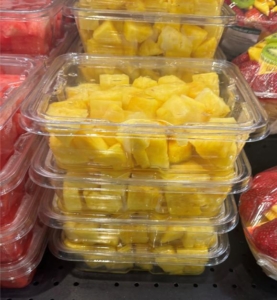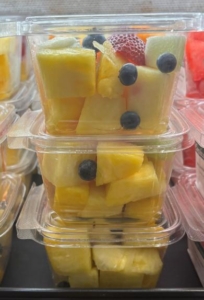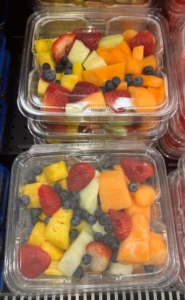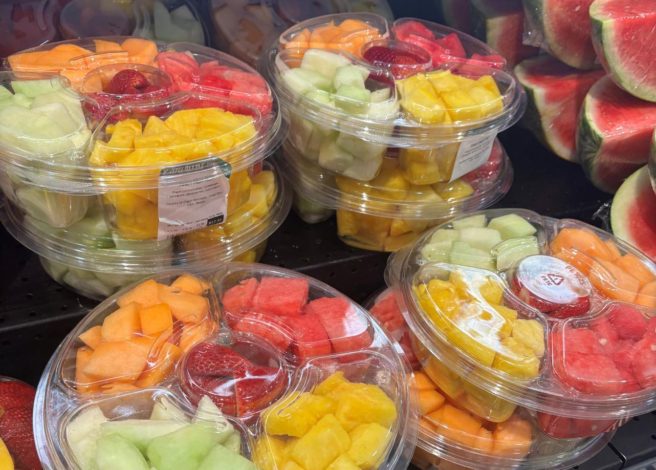At a Glance
- Fruit purge control is essential — managing expelled juices prevents soggy packaging, microbial growth, and product damage.
- Drainage systems (pads, trays, mesh) wick away excess liquid, keeping fruit fresh and appealing.
- Modified atmosphere packaging (MAP) reduces respiration and purge by adjusting gas levels around the fruit.
- Temperature control and rapid sealing are key — keeping fruit cold throughout processing limits purge and maintains quality.
Do you know that sensation after a big meal when you feel like you could just explode? Fruit can actually empathize with you. But when produce gets too “full” and starts leaking juice inside its packaging, it’s not just a mess — it’s a real issue. For food industry professionals, the expulsion of fruit juices — or “purge” in fresh food packaging — can affect their bottom line. But how does this happen? What does it do to the food? Can it be prevented?
This week, our discussion table hosted Jeff Brandenburg, who brings 45 years of packaging technology expertise as the founder of The Qfresh Lab/JSB Group. Brandenburg blends his background in Chemical and Biomedical Engineering with Food Safety knowledge, while also serving as both a university instructor and industry advisor. His career has been focused on addressing the changing challenges in fresh food packaging solutions.
This article will explore how that innocent-looking tray of watermelon chunks might harbor a fascinating biological drama that directly impacts quality, shelf life, and consumer satisfaction. We will also provide tips on how to protect your food business from “the purge.”
The Great Metabolic Switch
 Before we discuss “fruit purging” (which still sounds odd), let’s clarify a few key points. Living plants and harvested fruits operate under different metabolic systems. When a plant is growing happily in the ground, it’s engaged in photosynthesis — taking in carbon dioxide and releasing oxygen. But the moment we harvest that produce, everything changes.
Before we discuss “fruit purging” (which still sounds odd), let’s clarify a few key points. Living plants and harvested fruits operate under different metabolic systems. When a plant is growing happily in the ground, it’s engaged in photosynthesis — taking in carbon dioxide and releasing oxygen. But the moment we harvest that produce, everything changes.
After harvest, fruits and vegetables enter respiration mode. They use oxygen and release carbon dioxide. This shift leads to a series of biological changes. These changes directly influence how produce performs in its packaging. And one of those changes, under the right (or rather, wrong) conditions, is purging.
Two Types of Produce Purge
When we talk about “purge” in fresh-cut produce, we’re referring to the liquid that accumulates in the package. However, as anyone who’s had their lunchbox leak mysterious juices by recess can attest, not all purge is created equal:
Normal Purge: The Inevitable Consequence of Cutting
When you slice through watermelon, pineapple, or tomatoes, you’re cutting through cell walls — the rigid outer structures that surround and protect each plant cell, giving the fruit its shape and firmness. This naturally releases some liquid — what we might call “normal purge.” This type of liquid release is inevitable but manageable with proper packaging design — such as elevated bases that allow juices to drain away from the product, keeping it fresh and visually appealing. Absorbent pads can also be placed at the bottom of the package to soak up excess liquid and prevent pooling.
Anaerobic Purge: The Warning Sign
The second type is far more problematic. As fresh-cut produce consumes oxygen, it releases carbon dioxide. Since the produce has been cut, it reacts with a “physiological wound response,” kind of like how your heart rate increases when you sustain an injury. This increased respiration rate is essentially “choking” the product. In a sealed container, it changes metabolism from aerobic (with oxygen) to anaerobic (without oxygen). This metabolic shift has dramatic consequences:
- Cellular breakdown: The cell walls fall apart, releasing much more liquid — like “opening the floodgates.”
- CO₂ buildup: Carbon dioxide levels skyrocket inside the package
- Off-flavor development: In anaerobic conditions, unpleasant esters and aldehydes can develop. Esters, such as ethyl acetate and isoamyl acetate, are commonly produced during fermentation. Ethyl acetate has a fruity smell similar to pears, while isoamyl acetate smells like bananas. Aldehydes, like acetaldehyde and benzaldehyde (hope you brushed up on those chemical pronunciations!), can also form. Acetaldehyde has a sharp, pungent smell, often described as green apple-like, while benzaldehyde has a sweet, almond-like aroma. So while your fermentation might smell like a fruit salad gone wrong, at least you’ll know exactly which compounds are throwing the party.
The visual difference is clear. Produce affected by anaerobic purge looks “water-soaked.” It feels soft and over time, may taste carbonated because of dissolved CO₂. That’s right: carbonated. If your package contains watermelon soda, you’ve got a problem.

Why Purge Management Matters
For food industry professionals, understanding and managing purge is crucial for several reasons:
Food Safety Concerns
Purge liquid creates an ideal environment for spoilage bacteria. These may not cause disease, but they speed up product spoilage. They can also lead to bad flavors and smells. Quite simply, it makes the product look and taste unappetizing.
Quality Perception
Consumers buy with their eyes first. A package floating in liquid sends quick quality warnings to shoppers. This happens no matter how safe or tasty the product inside is.
Shelf Life Reduction
Produce sitting in purge liquid deteriorates faster. Moisture speeds up cell breakdown. This can cause that unwanted “water-soaked” look that shoppers don’t like.
Vulnerable Products: Which Ones Are at Risk?
While all cut produce releases some liquid, certain items are particularly prone to problematic purge and are known as “high moisture” fruits and vegetables. Examples include:
- Watermelon: The classic example, notorious for dramatic purge issues when packaging isn’t optimized
- Other melons: Cantaloupe, honeydew, etc.
- Tomatoes: Technically a fruit (the ongoing debate) and behaves accordingly
- Pineapple: High moisture content makes it susceptible
- Cucumbers: To a lesser extent than the above examples
Solutions: The Science of Proper Packaging
Managing purge effectively requires a two-pronged approach:
Oxygen Management
 The primary goal is preventing anaerobic conditions. This needs packaging with the right oxygen transmission rates. This can be done using micro-perforations, breathable films, or other methods. These solutions maintain adequate oxygen levels inside the package.
The primary goal is preventing anaerobic conditions. This needs packaging with the right oxygen transmission rates. This can be done using micro-perforations, breathable films, or other methods. These solutions maintain adequate oxygen levels inside the package.
Liquid Management
Even with proper oxygen levels, some normal purge will occur. Several technologies address this:
- Absorbent pads: Capture and hold liquid away from produce
- False bottoms: Create separation between produce and accumulated liquid
- Specialized trays: Companies have developed innovative solutions specifically for purge management
Your Purge-Prevention Checklist
Learning about fruit purge aids in smarter packaging choices. It results in longer shelf life, enhanced appearance, and more satisfied consumers. When developing packaging for fresh-cut produce, particularly high-moisture fruits:
- Ensure that oxygen transmission rates match the respiration rates of your specific product.
- Implement appropriate liquid management strategies for the inevitable, normal purge.
- Test thoroughly under real-world conditions to verify your packaging maintains aerobic conditions throughout the target shelf life.
- Consider temperature fluctuations in your distribution chain, as these can dramatically impact respiration rates.
By focusing on these factors, you’ll avoid the costly “floodgates” scenario of anaerobic purge while maintaining the crisp, fresh appearance consumers expect.
The Fresh Fruits of Your Labor
 Remember: that innocent-looking tray of fruit chunks is still very much alive, undergoing complex metabolic processes that directly impact quality. Respecting the biology behind the product is the first step toward packaging success.
Remember: that innocent-looking tray of fruit chunks is still very much alive, undergoing complex metabolic processes that directly impact quality. Respecting the biology behind the product is the first step toward packaging success.
When shoppers see your competitors’ watermelon chunks sitting in puddles while yours look fresh and appetizing, you’ve won more than just the visual comparison. Your customers notice the difference too — they trust your quality, return for more, and you waste less product while improving profits. That’s the real payoff of choosing the right packaging.
Are you interested in learning more about how fresh produce reacts in food packaging? Visit our Learning Center today! If you have any questions, don’t hesitate to reach out. We’re here to help.
Interested in learning more about The QFresh Lab /JSB Group, LLC? Visit their website or contact them directly.

